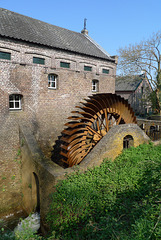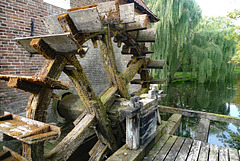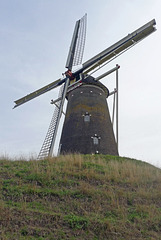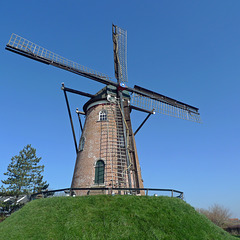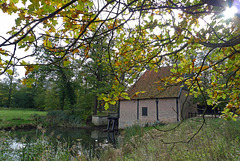
Nederland: wind- en watermolens
Folder: Nederland - the Netherlands
Foto's van Nederlandse wind- en watermolens.
Nederland - Akersloot, De Oude Knegt
| |
|
|
|
Although the name De Oude Knegt (The Old Servant) suggests otherwise, the current windmill is relatively young and dates just from the year 2004.
However, its history goes back for centuries. As early as 1333 documents speak of a corn mill in the village of Akersloot. It is almost certain that the very first post mill was burned down by the Spaniards during the siege of Alkmaar (1573). In 1580, the village council of Akersloot decided to rebuild a corn mill, which would be owned by the village community.
This mill was probably in operation until 1817, when De Oude Knegt is mentioned.In that year the mill was replaced by an octagonal mill, which was moved from elsewhere. This mill remained in operation for more than hundred years. In 1925 the mill was disassembled and partly demolished.
A local initiative ensured that the mill was rebuilt on a new spot in 1981. For many years the mill supplied flour to private customers and to a number of bakers in the area. But at the turn of the year 2000 - 2001 the mill burned down completely. Thanks to the efforts of volunteers, the mill could be rebuilt. In 2004 the project was completed and De Oude Knegt was festively put into operation as a corn mill.
De Oude Knegt is open to visitors (Wednesdays and Saturdays) and flour products are sold in the miller's house.
Nederland - Alkmaar, Molen van Piet
| |
|
|
|
De Molen van Piet (or officially “De Groot”) is located in the city centre of Alkmaar on the top of the former rampart, towering above the surrounding urban development.
This windmill with a stage was built in 1769 and from then on served as a corn mill for ages. In the year of 1874 the mill is owned by miller S. de Groot. Ten years later mill "De Groot" is bought by C. Piet, who came from Aalsmeer and was a miller in Sloten. He had a house made at the lower floors of the mill. The mill's surname remained popularly associated with the mill and the old name “De Groot” is hardly used. Nowadays the fourth generation of the Piet family still lives in the mill.
The mill is now owned by the municipality, but is still inhabited and milled - every now and then - by a member of the Piet family. Only during special occasions the mill can be visited.
Nederland - Apeldoorn / Wenum, Oranjemolen
| |
|
|
|
Windmill Oranjemolen ('t Haasje) in Wenum (north of Apeldoorn), after the restoration.
Nederland - Apeldoorn, Wenumse Enk
| |
|
|
|
Wenum is more of a hamlet, coming into being on a east-west ridge of sand. The landscape around Wenum is characterized by streams, fields and meadows close to each other. This small scale landscape changes gradually eastwards into an open agricultural landscape.
Characteristic is the Wenumse Enk ('upland field’), a large spherical open field on the
sand ridge. Landmark of this Enk is the windmill ‘Oranjemolen’, also called ‘t Haasje’ (PiP).
Nederland - Apeldoorn / Wenum, watermolen
| |
|
|
|
Wenum - watermill: built in or even before the year 1313 it was first a grain mill. In the 18th century the mill was used as a copper mill. In 1917 the stone building was built and the mill used again as a flourmill
Nederland - Arcen, Wijmarsche Watermolen
| |
|
|
|
The Wijmarsche mill belonged to the estate of the Castle of ‘Heerlycheit Arcen’ and was already mentioned in documents in the year of 1498, although it then was located on a different place. Two centuries later, the mill was affected by the ravages of war and demolished in 1677. Rebuilding of the mill took place the same year on its present location.
Originally the mill building had two floors; the grain mill was located in the northern part and in the southern was an oil mill, having each their own water wheel. Early 19th century the building was extended with a third storey, executed in skillfully masonry.
In the years of 1881 – 1882 the oil mill disappeared and the flour mill was renovated again. In 1917 the mill was closed, due to strong competition from industrial mills. The building was severely damaged in World War II and fell into a ruin. The heirs of the last owner tried to restore the mill in the fifties, but due to the poor condition it failed.
In 1978 a foundation (Stichting Het Limburgs Landschap) took over the mill and in collaboration with local initiatives the restoration of the ‘Wijmarsche Watermolen’ Arcen was accomplished. In 1993 the mill could be used as a corn mill again. Nowadays the mill is leased to ‘Graanbranderij de IJsvogel’ (an alcohol distillery) and can be visited.
More info about the mill (Dutch): waterradmolens.nl/LimburgN/Arcen.htm
More info about the distillery (Dutch): www.ijsvogel.com
Nederland - Arnhem, Witte Watermolen
| |
|
|
|
The ‘Witte Watermolen’ (White Watermill) is a flour mill in ‘Park Sonsbeek’ along the ‘St. Jansbeek’. The current mill was built around the year of 1470 on the location of an older mill (Jammerloes Molen), commissioned by the Benedictine Abbey of St. Salvador in Prüm, owner of the land around the brook.
Nowadays the ‘Witte Watermolen’ is the last remnant - and only functional one - of the ten watermills along the ‘St. Jansbeek’. Further upstream stands the ‘Begijnenmolen’, which is not used anymore, but houses the ‘Nederlands Watermuseum’.
The ‘Witte Watermolen’ has been restored (1966-1967) and is equipped with three pairs of millstones two of which are used for grinding grain. A professional miller and volunteers are operating the mill several times a week. The mill has a shop, which sells flour and freshly made pancakes.
Nederland - Barger-Compascuum, De Berk
| |
|
|
|
Windmill De Berk (The Berch) originally came from Drantum in Germany. The windmill was built in 1870 as a successor of a windmill that had been built in the middle of the 19th century, but had burnt down. In 1952, this mill was put out of action and fell into disrepair.
Miller Bökkers from the (Dutch) town of Olst bought the mill with the intention of rebuilding it. His plans were not realised and in 1983, De Berk was rebuilt in the Veenpark - an open-air museum in Barger-Compascuum, Drenthe. Here, the windmill operated regularly, grinding grain as well.
De Berk is an octagonal smock mill on a two storey brick base. It has a stage at first floor level (3.2 metres above ground level). The smock and cap are thatched.
The flourmill was doing well until 2009, but then it was obvious that the mill could only be used to a very limited extent, only when the wind came from the right angle. This became less and less and slowly the mill stopped functioning and its overall condition continued to deteriorate.
During my visit, I indeed noticed how ill-maintained De Berk is. To be honest one the worst maintained windmills in the Netherlands that I have ever seen. It is feared that the mill is beyond saving.
Nederland - Beekbergen, Ruitersmolen
Nederland - Beesel, 'De Grauwe Beer'
| |
|
|
|
'De Grauwe Beer' (Grey Bear) is a so called 'belt mill' (a 'belt' is a man made hill).
September 2014: the mill has been moved 50 meters further away from the river to protect it for possible floodings.
Nederland - Bellingwolde, Veldkamp's Meuln
| |
|
|
|
Veldkamp's Meuln (Veldkamp’s Mill) is a 19th century seven storey tower mill, with a stage at the third floor level. The mill was built in 1855 as a grist and oil mill and owned by the Veldkamp family for many years, which explains the name of the mill.
During its existence the mill was regularly damaged by storms, namely in 1895, 1972 and 1976. The mill was restored several times, the last time in 2002. Since then, the mill is regularly operated by a volunteer miller. Most of the husking machinery has disappeared, the mill still possesses two pairs of millstones.
Since the year of 1972 the mill is a national heritage site. Nowadays Veldkamp's Meuln is owned by the municipality. The mill is open for visitors, although it has limited opening hours.
Nederland - Borculo, De Olliemölle
| |
|
|
|
De Olliemölle consists of two separate water wheel mills. The one on the left was formerly an oil mill and was changed to a flour mill in 1920. The mill on the righthand side is a corn- and hulling mill.
The mills and their predecessors have traditionally belonged to Heerlijkheid Borculo , which came into the possession of the Van Bronckhorst family at the end of the 14th century. Borculo came into the possession of Stadholder Willem V van Oranje via inheritance in 1777.
In 1812, during the era of the French Empire, the complex was sold at a public auction. Around 1875, the right-hand mill building housed a chicory factory, which burned down in 1880 but was rebuilt a year later.
On 10 August 1925, a tornado destroyed much of Borculo. Damage at the water mills was limited: all the roof tiles were gone but the rest remained intact.
In 1957, the Borculo municipality came into possession of the entire mill complex and had it restored in 1966. At the end of 2007, both mill buildings were sold. The new owners established catering establishments in both buildings. De Olliemölle is located in the heart of Borculo on a side brench of the river Berkel.
Nederland - Bredevoort, De Prins van Oranje
| |
|
|
|
Bredevoort - once a walled city - received permission from Stadholder Frederik Hendrik to build a post mill in 1644. This mill - De Prins van Oranje - was built on one of the city's bastions. After the mill burned down in 1869, the current brick beltmolen (belt = a man-made mound) was built a year later.
De Prins van Oranje remained in operation for almost the entire 20th century, with necessary modernisation taking place. The mill was restored in 1968 and continued to operate thereafter. In 1990, this seemed to have ended due to damage, but repairs followed two years later. The mill is still milling and is often milled by voluntary millers.
De Prins van Oranje is listed as a Dutch national monument.
Nederland - Bronkhorster Molen
| |
|
|
|
The Bronkhorster Molen is a corn mill built in 1844. The mill – from brick with a round shape - is a so called beltmolen (a belt is man made mound); the mound has a height of 3.30 meters. Already in the year of 1482 there stood a postmill on this spot, which burned down in 1844. The lords of Bronkhorst had the right to use the wind until 1795. The inhabitants of Bronkhorst were obliged to have their corn grinded in their mill soke.
The mill was in operation as a grinding unit until just after the Second World War, after which it fell into disrepair. In 1960, the mill was partially restored and in 1989 it underwent another major renovation. In the meantime, the mill is owned by the municipality of Bronckhorst. The mill is capable of grinding and is operated by volunteers. In the mound of the mill there is a shop where various kinds of flour are sold.
Nederland - Cadzand, 'Nooit Gedacht'
| |
|
|
|
Approaching Cadzand one can not miss its windmill ‘Nooit Gedacht’ (English: have never thought) in the flat landscape of the most western part Zeelandic Flanders, as it is a so called ’beltmolen’. A ‘belt’ is a man made hill. ‘Nooit Gedacht’ is - as often mills do - visually dominating the scenery.
An older mill - de Kat - on the same spot burned down in 1897 and already one year later the present mill was built. During the liberation of Zeelandic Flanders in World War II the mill had severe damage. In 1974 the inhabitants of Cadzand were alarmed by a huge fire in the mill (in the meantime used as restaurant and bar). But again the mill was restored and opened again May 1977.
Since that moment it is used again as a flour mill. ‘Nooit Gedacht’ is open for public on Sunday afternoon and during summer season also on Wednesday afternoon.
More info (Dutch): www.molendatabase.nl/nederland/molen.php?nummer=868
Nederland - Camperduin, Hargermolen
| |
|
|
|
The Hargermolen (Harger Mill) is a polder drainage mill, which was built in 1804. The current mill replaced an earlier mill, which was destroyed during fighting between an Anglo-Russian army and the then French rulers of the Netherlands. This area has been home to a windmill since the early 15th century, but where the original mill was destroyed, the current structure has survived the ravages of storms and fire.
The reed-covered octagonal Hargermolen was used to drain the Harger- en Pettemerpolder . Until 1962 the mill was solely operated by wind. In that year a diesel engine was added. Nowadays the mill is still suitable for drainage the polder and is working on an occasional basis, manned by a volunteer.
Nederland - Delden, Noordmolen
| |
|
|
|
Overijssel (Twente) , Delden: Twickeler Vaart with the Noordmolen (a watermill), nearby Twickel Castle.
Nederland - Delden, De Noordmolen
| |
|
|
|
De Noordmolen is a watermill which is more than 650 years old. In May 1347, Herman van Twicklo bought Huize Eijsink and the Noordmolens (mills) situated along the Azelo stream from the nobleman Berend van Hulscher. The deed of sale has been preserved in the archives of Kasteel Twickel (Twickel Castle) in which mention is made of the Noordmolens. In the past, there was a corn mill opposite the present oil mill (see PiP4); this was demolished in 1831.
De Noordmolen has been restored several times. In 1917, the mill was repaired, but stood still, partly due to lack of water, leading to renewed decay. In the years 1976-1978, the mill building was once again restored by order of the Twickel foundation. In 1984, the mill received a new water wheel. A last major renovation took place in 2006.
De Noordmolen has always belonged to the Twickel estate. Since 1990, volunteers have kept the watermill in operation and visitors are able to see how oil is extracted from linseed.
Jump to top
RSS feed- Latest items - Subscribe to the latest items added to this album
- ipernity © 2007-2024
- Help & Contact
|
Club news
|
About ipernity
|
History |
ipernity Club & Prices |
Guide of good conduct
Donate | Group guidelines | Privacy policy | Terms of use | Statutes | In memoria -
Facebook
Twitter






